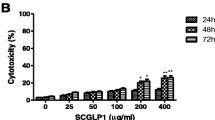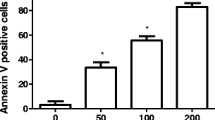Abstract
In this study, we isolated and purified one homogeneous polysaccharide (TRP) from the fruiting bodies of Trametes robiniophila Murrill, and its average molecular weight was estimated to be 8.7 × 104 Da. Monosaccharide composition analysis by gas chromatography (GC) indicated that TRP was composed of glucose, galactose, and arabinose in the molar ratio of 4.2:1.10:1.06. Particularly, we evaluated the anti-cancer efficacy of TRP on human osteosarcoma U-2 OS cells in vitro and associated possible molecular mechanism. Our result provided the first evidence that treatment of U-2 OS cells with TRP resulted in a dose- and time-dependent inhibitory effect on cell proliferation of U-2 OS cells and caused apoptotic death. Moreover, TRP induced the apoptosis of U-2 OS cells via a mitochondria-dependent pathway, as evidenced by an increase in Bax/Bcl-2 ratio, a loss of mitochondrial membrane potential (Δψm), release of cytochrome c from the mitochondria to the cytosol, activation of caspase-9 and caspase-3, and cleavage of poly(ADP-ribose) polymerase (PARP) in U-2 OS cells. In addition, overexpression of metadherin (MTDH), one carcinogene, was inhibited in U-2 OS cells after exposure to TRP for 24 h. Our findings suggested that TRP inhibited the proliferation of human osteosarcoma cancer cells by promoting apoptosis through the intrinsic mitochondrial pathway, as well as inhibition of MTDH expression.







Similar content being viewed by others
References
Chou AJ, Gorlick R. Chemotherapy resistance in osteosarcoma: current challenges and future directions. Expert Rev Anticancer Ther. 2006;6:1075–85.
Marina N, Gebhardt M, Teot L, Gorlick R. Biology and therapeutic advances for pediatric osteosarcoma. Oncologist. 2004;9:422–41.
Lee JA, Kim MS, Kim DH, Lim JS, Yoo JY, Koh JS, et al. Relative tumor burden predicts metastasis-free survival in pediatric osteosarcoma. Pediatr Blood Cancer. 2008;50:195–200.
Longhi A, Errani C, De Paolis M, Mercuri M, Bacci G. Primary bone osteosarcoma in the pediatric age: state of the art. Cancer Treat Rev. 2006;32:423–36.
Wu PK, Chen WM, Chen CF, Lee OK, Haung CK, Chen TH. Primary osteogenic sarcoma with pulmonary metastasis: clinical results and prognostic factors in 91 patients. Jpn J Clin Oncol. 2009;39:514–22.
Yang C, Choy E, Hornicek FJ, Wood KB, Schwab JH, Liu X, et al. Histone deacetylase inhibitor (HDACI) PCI-24781 potentiates cytotoxic effects of doxorubicin in bone sarcoma cells. Cancer Chemother Pharmacol. 2011;67:439–46.
Wittenburg LA, Bisson L, Rose BJ, Korch C, Thamm DH. The histone deacetylase inhibitor valproic acid sensitizes human and canine osteosarcoma to doxorubicin. Cancer Chemother Pharmacol. 2011;67:83–92.
Petrilli AS, de Camargo B, Filho VO, Bruniera P, Brunetto AL, Jesus-Garcia R, et al. Results of the Brazilian Osteosarcoma Treatment Group Studies III and IV: prognostic factors and impact on survival. J Clin Oncol. 2006;24:1161–8.
Zhang Y, Sun S, Chen J, Ren P, Hu Y, Cao Z, et al. Oxymatrine induces mitochondria dependent apoptosis in human osteosarcoma MNNG/HOS cells through inhibition of PI3K/Akt pathway. Tumour Biol. 2014;35:1619–25.
Wang Y, Chen J, Zhang D, Zhang Y, Wen Y, Li L, et al. Tumoricidal effects of a selenium (Se)-polysaccharide from Ziyang green tea on human osteosarcoma U-2 OS cells. Carbohydr Polym. 2013;98:1186–90.
Li L, Ye S, Wang Y, Tang Z. Progress on experimental research and clinical application of Trametes robiniophila. China Cancer. 2006;16:110–3.
Zhang N, Kong X, Yan S, Yuan C, Yang Q. Huaier aqueous extract inhibits proliferation of breast cancer cells by inducing apoptosis. Cancer Sci. 2010;101:2375–83.
Wang Y, Liu Y, Hu Y. Optimization of polysaccharides extraction from Trametes robiniophila and its antioxidant activities. Carbohydr Polym. 2014;111:324–32.
Zhang T, Wang K, Zhang J, Wang X, Chen Z, Ni C, et al. Huaier aqueous extract inhibits colorectal cancer stem cell growth partially via downregulation of the Wnt/β-catenin pathway. Oncol Lett. 2013;5:1171–6.
Ren J, Zheng C, Feng G, Liang H, Xia X, Fang J, et al. Inhibitory effect of extract of fungi of Huaier on hepatocellular carcinoma cells. J Huazhong Univ Sci Technolog Med Sci. 2009;29:198–201.
Huang T, Kong Q, Lu H, Dai G. Experimental study of extract of fungi of Huaier inducing apoptosis of the human adenocarcinoma of lung A549 cells. Chin J Tuberc Respir Dis. 2001;24:487–8.
Guo Y, Cheng P, Chen Y, Zhou X, Yu P, Li Y. Studies on the constituents of polysaccharide from the hyphae of Trametes robiniophila (II): identification of polysaccharide from the hyphae of Trametes robiniophila and determination of its molar ratio. J Chin Pharm U. 1992;23:155–7.
Guo Y, Cheng P, Chen Y, Zhou X, Yu P, Li Y. Isolation and analysis of the polysaccharide of Huaier mycelium. Chin J Biochem Pharm. 1993;63:56–9.
Matthaei JH, Jone OW, Martin RG, Nirenberg MW. Characteristics and composition of RNA coding units. Proc Natl Acad Sci U S A. 1962;48:666–7.
Dubois M, Gilles KA, Hamilton JK, Rebers PA, Smith F. Colorimetric method for determination of sugars and related substances. Anal Chem. 1956;28:350–6.
Bradford MM. A rapid and sensitive method for the quantitation of microgram quantities of protein utilizing the principle of protein binding. Anal Biochem. 1976;72:248–54.
Blumenkrantz N, Asboe-Hansen G. New method for quantitative determination of uronic acids. Anal Biochem. 1973;54:484–9.
Lehrfeld J. Simultaneous gas–liquid chromatographic determination of aldonic acids and aldoses. Anal Chem. 1985;57:346–8.
Jones TM, Albersheim P. A gas chromatographic method for the determination of aldose and uronic acid constituents of plant cell wall polysaccharides. Plant Physiol. 1972;49:926–36.
Oades JM. Gas–liquid chromatography of alditol acetates and its application to the analysis of sugars in complex hydrolysates. J Chromatogr. 1967;28:246–52.
Ashkenazi A, Dixit VM. Death receptors: signaling and modulation. Science. 1998;281:1305–8.
Green DR, Reed JC. Mitochondria and apoptosis. Science. 1998;281:1309–12.
Lavrik IN, Golks A, Krammer PH. Caspases: pharmacological manipulation of cell death. J Clin Invest. 2005;115:2665–72.
Wang S, Penchala S, Prabhu S, Wang J, Huang Y. Molecular basis of traditional Chinese medicine in cancer chemoprevention. Curr Drug Discov Technol. 2010;7:67–75.
Thompson CB. Apoptosis in the pathogenesis and treatment of disease. Science. 1995;267:1456–62.
Tsuruo T, Naito M, Tomida A, Fujita N, Mashima T, Sakamoto H, et al. Molecular targeting therapy of cancer: drug resistance, apoptosis and survival signal. Cancer Sci. 2003;94:15–21.
Reed JC. Apoptosis-regulating proteins as targets for drug discovery. Trends Mol Med. 2001;7:314–9.
Gross A, McDonnell JM, Korsmeyer SJ. Bcl-2 family members and the mitochondria in apoptosis. Genes Dev. 1999;13:1899–911.
Wolter KG, Hsu YT, Smith CL, Nechushtan A, Xi XG, Youle RJ. Movement of Bax from the cytosol to mitochondria. J Cell Biol. 1997;139:1281–92.
Rossé T, Olivier R, Monney L, Rager M, Conus S, Fellay I, et al. Bcl-2 prolongs cell survival after Bax-induced release of cytochrome c. Nature. 1998;391:496–9.
Yang SH, Chien CM, Lu MC, Lin YH, Hu XW, Lin SR. Up-regulation of Bax and endonuclease G, and down-modulation of Bcl-XL involved in cardiotoxin III-induced apoptosis in K562 cells. Exp Mol Med. 2006;38:435–44.
Wu G, Chu J, Huang Z, Ye J, Chen P, Zheng C, et al. Xiao Jin Wan, a traditional Chinese herbal formula, inhibits proliferation via arresting cell cycle progression at the G2/M phase and promoting apoptosis via activating the mitochondrial-dependent pathway in U-2 OS human osteosarcoma cells. Int J Oncol. 2013;42:1070–80.
Petros AM, Olejniczak ET, Fesik SW. Structural biology of the Bcl-2 family of proteins. Biochim Biophys Acta. 2004;1644:83–94.
Chiang JH, Yang JS, Ma CY, Yang MD, Huang HY, Hsia TC, et al. Danthron, an anthraquinone derivative, induces DNA damage and caspase cascades mediated apoptosis in SNU-1 human gastric cancer cells through mitochondrial permeability transition pores and Bax-triggered pathways. Chem Res Toxicol. 2011;24:20–9.
Wei MC, Zong WX, Cheng EH, Lindsten T, Panoutsakopoulou V, Ross AJ, et al. Proapoptotic BAX and BAK: a requisite gateway to mitochondrial dysfunction and death. Science. 2001;292:727–30.
Korper S, Nolte F, Rojewski MT, Thiel E, Schrezenmeier H. The K+ channel openers diazoxide and NS1619 induce depolarization of mitochondria and have differential effects on cell Ca2+ in CD34+ cell line KG-1. Exp Hematol. 2003;31:815–23.
Susin SA, Lorenzo HK, Zamzami N, Marzo I, Snow BE, Brothers GM, et al. Molecular characterization of mitochondrial apoptosis inducing factors. Nature. 1999;397:441–6.
Hengartner MO. The biochemistry of apoptosis. Nature. 2000;407:770–6.
Thornberry NA, Rano TA, Peterson EP, Rasper DM, Timkey T, Garcia-Calvo M, et al. A combinatorial approach defines specificities of members of the caspase family and granzyme B. Functional relationships established for key mediators of apoptosis. J Biol Chem. 1997;272:17907–11.
Chang HY, Yang X. Proteases for cell suicide: functions and regulation of caspases. Microbiol Mol Biol Rev. 2000;64:821.
Li P, Nijhawan D, Budihardjo I, Srinivasula SM, Ahmad M, Alnemri ES, et al. Cytochrome c and dATP-dependent formation of Apaf-1/caspase-9 complex initiates an apoptotic protease cascade. Cell. 1997;91:479–89.
Khosravi-Far R, Esposti MD. Death receptor signals to mitochondria. Cancer Biol Ther. 2004;3:1051–7.
Nagata S, Golstein P. The Fas death factor. Science. 1995;267:1449–56.
Wang F, Ke ZF, Wang R, Wang YF, Huang LL, Wang LT. Astrocyte elevated gene-1 (AEG-1) promotes osteosarcoma cell invasion through the JNK/c-Jun/MMP-2 pathway. Biochem Biophys Res Commun. 2014;452:933–9.
Wang F, Ke ZF, Sun SJ, Chen WF, Yang SC, Li SH, et al. Oncogenic roles of astrocyte elevated gene-1 (AEG-1) in osteosarcoma progression and prognosis. Cancer Biol Ther. 2011;12:539–48.
Acknowledgments
This work was supported by the grants from Heilongjiang Research Topics Fund (GC09C412-2) and Natural Science Foundation of Heilongjiang Province fund (H201454).
Conflicts of interest
None
Author information
Authors and Affiliations
Corresponding author
Rights and permissions
About this article
Cite this article
Zhao, X., Ma, S., Liu, N. et al. A polysaccharide from Trametes robiniophila Murrill induces apoptosis through intrinsic mitochondrial pathway in human osteosarcoma (U-2 OS) cells. Tumor Biol. 36, 5255–5263 (2015). https://doi.org/10.1007/s13277-015-3185-9
Received:
Accepted:
Published:
Issue Date:
DOI: https://doi.org/10.1007/s13277-015-3185-9




